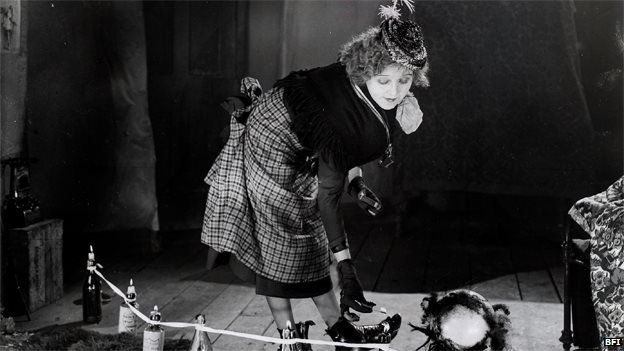Silent Betty Balfour film 'masterpiece' found in Holland
- Published

A lost masterpiece of British silent cinema has been discovered in the Netherlands.
Love, Life and Laughter, written and directed by George Pearson, was made in 1923 and had been one of the British Film Institute's 75 Most Wanted films.
Starring Betty Balfour, Britain's most successful silent actress, it told the story of Tip Toes, a chorus girl who falls for an impoverished author.
The BFI says it hopes to screen the 90-minute film in the UK later this year.
The film had been gathering dust in a small cinema in the Netherlands for more than 80 years.
In 2012, when the building was about to be redeveloped, an employee at a local television station took a number of film canisters to EYE, the Dutch film museum.
Love, Life and Laughter was eventually found while the contents were being catalogued.
"This is a major discovery, featuring Betty Balfour, the biggest female star of the silent period," said Bryony Dixon, curator of silent film at the BFI.
"It is also a rare survival of the work of George Pearson, one of Britain's most talented directors of this time, whose First World War drama Reveille is another film on the BFI's most wanted list."
When Love, Life and Laughter was released in 1923, many critics were still sceptical about the value of cinema, and British cinema in particular.
Pearson was an exception, often compared favourably with Dickens, whom he loved - and he advocated film in numerous articles and public lectures, calling it the "lingua franca of the human eye".
Only one other complete film by Pearson survives, making the discovery of Life, Love and Laughter "particularly significant", said the BFI.
Until now, the only trace of its existence was a collection of six production stills held in the BFI archive, along with a publicity leaflet and a fully illustrated campaign booklet.
The latter includes a flowery synopsis of the film, which begins: "There was once a happy little chorus girl who lived alone in a garret; and there was a lonely boy in the attic above who wrote tales nobody wanted - except perhaps the girl.
"One day he started to write the strange story of their two lives."
The chorus girl was played by Balfour, known as the "Queen of Happiness" for her ebullient comic performances.
She starred in a series of films as the recurring character of Squibs, a Cockney flower girl working in Piccadilly Circus, which were also directed by Pearson in the 1920s.
Indeed, Squibs was so popular that in the Netherlands, Life, Love and Laughter was re-titled Squibs als Tip-toes; De Koningin van de Music-halls (Squibs as Tip-Toes; the queen of the music-halls).
Contemporary reviews of the film singled out the actress for praise, with The Times calling her "the cleverest comedienne playing in British films".
The Evening News predicted: "What few people there are who have not fallen beneath the spell of her pretty face, clever comedy, and sympathetic interpretation of human feelings must surely be captured now."
However, not every aspect of the film was so well received, with The Times scolding Pearson for "a sudden anti-climax, which leaves the principal characters about to 'live happily ever after', in spite of every indication to the contrary".
The newspaper also praised the title cards as being "humorous and in the best of taste". However, these do not survive in the newly-discovered print, which features intertitles in Dutch.
The film's success was somewhat overshadowed in 1924, when screenwriter Susan Schofield sued Pearson, claiming he had stolen the story from her unmade script The Ragpicker.
The claim was eventually dismissed at London's High Court, where Mr Justice Astbury ruled that, despite "many resemblances" between the two scripts, the defendant had not been able to prove that Mr Pearson had prior knowledge of her screenplay.
- Published25 September 2013
- Published8 August 2013
- Published18 December 2013